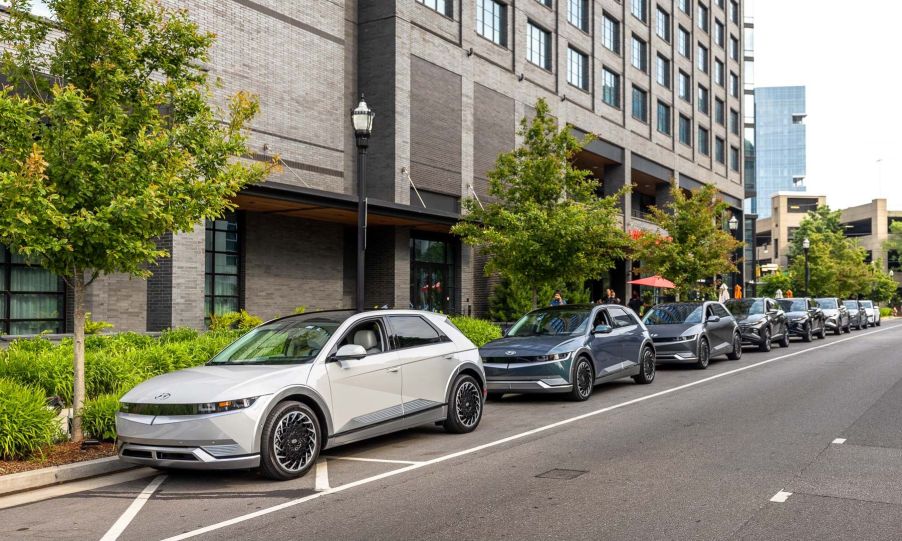
4 Reasons to Buy a 2022 Hyundai Ioniq 5, Not a Hyundai Kona Electric
The Hyundai Ioniq 5 is an all-new electric SUV with promising specs and a futuristic body design. However, with so many fresh and returning EVs, does the Ioniq 5 have what it takes to compete?
Previously, we reported justifiable reasons to choose the Hyundai Kona Electric over the Ioniq 5. True, the Hyundai Ioniq 5’s standard powertrain is less efficient, and the car demands a higher MSRP. However, we have a few more reasons to buy this electric SUV over the Kona EV.
1. The Ioniq 5 has available AWD

According to Hyundai, the Ioniq 5 can be optioned with AWD, and the Kona EV can’t. This requires you to upgrade to the dual-motor setup, which costs $3,500. The SE RWD starts at $44,000.
For that price, you also get a full safety suite with several crash-preventing features and new technology. Only a handful of features, such as a surround-view camera system and automatic perpendicular parking, aren’t included.
The interior is composed of primarily recycled materials, though it doesn’t look as interesting as the exterior. Despite this, most riders should be pleased with the abundance of standard convenience technology. Consumer Reports says that the infotainment system has fast response times and a user-friendly layout.
The standard cloth seats were comfortable enough for CR’s liking and even come with standard heating. You can also get faux leather seats on the two higher trims. Both rows have plenty of legroom for passengers, regardless of height.
2. The Hyundai Ioniq 5 offers more potential range
If you stick with the Hyundai Ioniq 5 FWD and get the larger battery option, you’ll get 303 miles of range. In comparison, the Hyundai Kona Electric only gets 258 miles of range. That’s comparable to the Hyundai Ioniq 5’s smaller battery pack, which gets 256 miles of range.
While their ranges are nearly identical, the dual-motor Ioniq 5 has a combined 320 horsepower on tap. The Hyundai Kona Electric makes 201 hp, though it’s still agile because of its lighter curb weight. Hyundai shows us that this is the Kona EV’s sole powertrain.
Still, Consumer Reports gave the Ioniq 5 a higher overall score compared to the Kona Electric. The Kona EV is faster and quieter than the gas-powered Kona, but its stiff suspension can cause discomfort on extended drives. Consumer Reports also said that the Kona EV suffers from a finicky brake pedal and lower predicted reliability.
CR found that the Ioniq 5 is nearly 2 seconds faster than the Kona in 0-60 mph acceleration. It also has better brakes and a smoother suspension, plus the zippy handling of a smaller car.
3. You get faster charging times with the Ioniq 5
Another gripe Consumer Reports had about the Hyundai Kona Electric was that it takes over 9 hours to charge the battery. The Hyundai Ioniq 5 can fully recharge its battery in 8.5 hours. Additionally, Hyundai claims that hooking your Ioniq 5 up to a DC fast-charger for 18 minutes can restore 70% of the battery.
4. The Hyundai Ioniq 5 has more cargo capacity
Edmunds tells us the Hyundai Ioniq 5 has over 60 cubic feet of available cargo capacity. With every seat up, you get a little over 27 cubic feet of storage. Consumer Reports says there are also plenty of deep storage cubbies in the cabin, particularly the center console.
The Hyundai Kona Electric only has about 19 cubic feet of cargo capacity behind the rear seats. Fold those down, and you get about 46 cubic feet.
Overall, both are excellent vehicles with healthy electric ranges. However, if you have more passengers and desire more performance capabilities, the Ioniq 5 might be the best fit.



